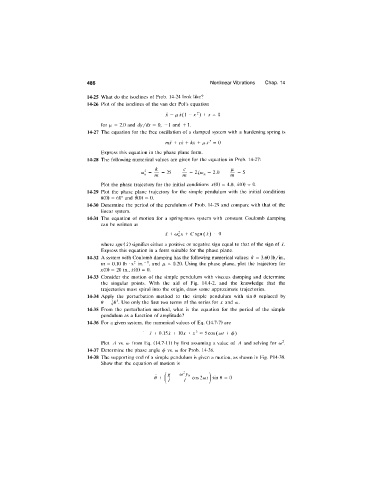Page 499 - Thomson, William Tyrrell-Theory of Vibration with Applications-Taylor _ Francis (2010)
P. 499
486 Nonlinear Vibrations Chap. 14
14-25 What do the isoclines of Prob. 14-24 look like?
14-26 Plot of the isoclines of the van der Pol’s equation
X —¡ix{\ - x^) + x = 0
for fji = 2.0 and dy/dx = 0 ,- 1 and +1.
14-27 The equation for the free oscillation of a damped system with a hardening spring is
mx + cx + kx + jjLX^ = {)
Express this equation in the phase plane form.
14-28 The following numerical values are given for the equation in Prob. 14-27:
cof, = — = 25 — = = 2.0 -^ = 5
^ m m '' m
Plot the phase trajectory for the initial conditions x(0) = 4.0, i(0) = 0.
14-29 Plot the phase plane trajectory for the simple pendulum with the initial conditions
0(0) = 60° and 0(0) = 0.
14-30 Determine the period of the pendulum of Prob. 14-29 and compare with that of the
linear system.
14-31 The equation of motion for a spring-mass system with constant Coulomb damping
can be written as
X + o)^^x + C sgn ( i) = 0
where sgn (i) signifies either a positive or negative sign equal to that of the sign of i.
Express this equation in a form suitable for the phase plane.
14-32 A system with Coulomb damping has the following numerical values: k = 3.60 Ib/in.,
m = 0.10 lb • s^ in.~\ and ¡i = 0.20. Using the phase plane, plot the trajectory for
x(0) = 20 in., i(0) = 0.
14-33 Consider the motion of the simple pendulum with viscous damping and determine
the singular points. With the aid of Fig. 14.4-2, and the knowledge that the
trajectories must spiral into the origin, draw some approximate trajectories.
14-34 Apply the perturbation method to the simple pendulum with sin 0 replaced by
0 - ¿0^. Use only the first two terms of the series for x and w.
14-35 From the perturbation method, what is the equation for the period of the simple
pendulum as a function of amplitude?
14-36 For a given system, the numerical values of Eq. (14.7-7) are
X + 0.15i + lOx + = 5 cos (ct>i + (/>)
)
Plot A vs. (X from Eq. (14.7-11) by first assuming a value of A and solving for o)^.
14-37 Determine the phase angle (/> vs. m for Prob. 14-36.
14-38 The supporting end of a simple pendulum is given a motion, as shown in Fig. P14-38.
Show that the equation of motion is
0 + I j - — cos 2ct)t I sin 0 = 0

